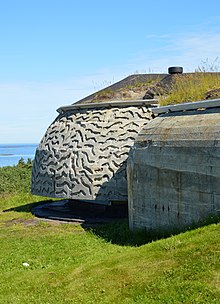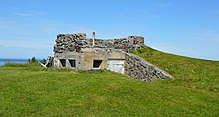Army Coast Battery 17./976 Bud
The Army Coast Battery 17./976 Bud is a former German coastal battery in the village of Bud in the Norwegian municipality of Hustadvika . The remains of the listed complex are now operated as the Ergan Kystfort Museum .
location
The battery is elevated on the Ergan hill in the northern part of the village directly on the coast of the North European Sea at the entrance to the Harøyfjord . To the southeast is Bud Church , to the south the Stone Park . The Bud building stone is located on the site .
History of the battery
In the course of the occupation of Norway by German troops during World War II , the German military reached Bud and Ergan in early May 1940. The Army Coast Artillery Department 486 was set up in May 1941 in Berlin . The Army Coast Battery 976 in Bud, built with four guns from the spring of 1941, belonged to it. It was part of the Atlantic Wall . The battery rooms, including the command post, were cut into the rock. During the construction in 1941, the building stone erected in 1933 was laid down by Bud. Work on building the battery was completed in 1943. However, further work was carried out repeatedly until 1945. The construction was carried out by the Todt Organization , which handled the design and construction with 40 people. 110 Polish prisoners of war living in the schoolhouse and 40 Soviet prisoners of war living in Bedehuset were used for the construction work .
The complex was one of 1,500 defensive structures along the Norwegian coast. The construction was carried out to counter a feared landing of the Allies from the sea and to secure the area of the coast of Romsdal .
The battery's crew consisted of about 90 soldiers. In addition to two officers, 13 NCOs, 52 crew members and 20 infantrymen were deployed. In addition, eight soldiers were posted here for air defense . The facility also included the sea defense radar set up in Kjeska and the corresponding liaison personnel . The battery belonged to the army, but was subordinate to the German naval commander Molde for operations at sea . On the land side, it was under the infantry division stationed in Dombås .
The battery was only actually used once for military purposes. Relations with the local population were tense. This resulted from the rough treatment of the prisoners of war by the German side. In 1942/43, for a military technical purpose, 36 residential houses, eight barns and several other buildings on the coast were demolished, which was catastrophic for the civilian population affected. The local population got involved with the prisoners of war and partially joined the civil and military resistance. This was expressed in the church struggle, school struggle and passive resistance by the local authorities. However, major resistance actions and repressive reactions on the German side did not materialize.
After the German surrender, the battery was dismantled from May to November 1945. While the barracks and inventory were being sold, the weapons and ammunition were sunk in the sea. The abandoned building stone was rebuilt in 1946.
museum
The museum belongs to the Romsdalmuseet . It has a 100-seat lecture hall, meeting rooms, cloakroom and kitchen in a museum building specially built on the site. On the one hand, it deals with the topic of the Second World War. It shows the restored military installation including weapons, equipment, technical details and personal items. The local history during this time is also discussed.
Another part is a coastal cultural exhibition dedicated to life on the coast since the Stone Age . The story of the fishing village of Bud, the underwater archeology with wreckage finds in the Hustadvika , the development of the Ormen Lange gas field and the recent cultural history of the region are presented. A film provides information about the Storegga slide. Another topic is the history of fish farming, the fishing for cod and herring as well as the clipfish and the processing of seaweed . In addition, the dangerousness of the coast is described in particular with the description of the sinking of the DS Rokta on April 3, 1938 near Gallerskjæra .
literature
- Bud Museum, Ergan Kystfort and Coastal Culture Exhibition , leaflet, no year (around 2017)
Web links
Coordinates: 62 ° 54 ′ 30.1 ″ N , 6 ° 54 ′ 18.7 ″ E




